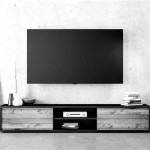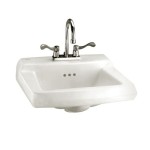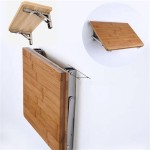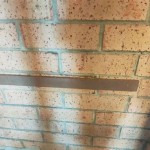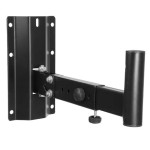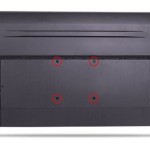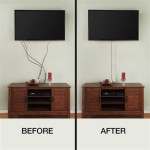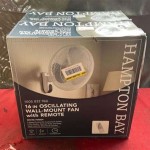TCL 65 Inch Wall Mount: A Comprehensive Guide
Mounting a television, specifically a 65-inch TCL model, to a wall can dramatically enhance viewing experiences and optimize space utilization. This article provides a comprehensive guide to understanding the considerations, preparations, and processes involved in successfully wall-mounting a TCL 65-inch television. It addresses essential aspects such as VESA compatibility, wall type assessment, selection of appropriate mounting hardware, installation procedures, cable management, and troubleshooting common issues. Careful planning and execution are crucial to ensure a safe, secure, and aesthetically pleasing installation.
The decision to wall-mount a television often stems from several motivations. Space saving is a primary factor, particularly in smaller rooms where a traditional entertainment center would occupy significant floor space. Wall mounting also offers improved viewing angles, as the television can be positioned at an optimal height for viewers. Furthermore, it can enhance the room's aesthetic appeal by creating a cleaner, more modern look. Security is another consideration, as a properly mounted television is less susceptible to being accidentally knocked over or stolen. However, it is important to acknowledge that wall mounting is not suitable for all situations or individuals. Those unfamiliar with home improvement projects may prefer professional installation services.
Understanding VESA Compatibility
VESA (Video Electronics Standards Association) compatibility is a critical aspect of wall mounting any television. VESA standards define the hole pattern on the back of the television that is used to attach the wall mount bracket. This standardized pattern ensures that various wall mounts are compatible with different television models. A 65-inch TCL television will have a specific VESA pattern, typically expressed in millimeters (e.g., 400x200mm, 400x400mm, or 600x400mm). This measurement refers to the horizontal and vertical distances between the mounting holes.
Before purchasing a wall mount, it is essential to identify the television's VESA pattern. This information can usually be found in the television's user manual or on the manufacturer's website. Alternatively, one can manually measure the distance between the mounting holes on the back of the television. Once the VESA pattern is determined, selecting a wall mount that is specifically rated for that pattern is imperative. Using an incompatible wall mount can lead to instability, damage to the television, or even hazardous situations.
Wall mounts are typically categorized based on their weight capacity. A 65-inch TCL television can weigh upwards of 50 pounds, depending on the specific model. Therefore, the chosen wall mount must be rated to support the television's weight with a significant margin of safety. It is advisable to choose a mount that can handle at least 1.5 to 2 times the television's weight to ensure adequate stability and prevent potential failures. Ignoring the weight rating can result in the mount failing, potentially causing damage to the television and the wall.
Assessing Wall Type and Structure
The type of wall onto which the television will be mounted is a crucial factor to consider. The most common wall types are drywall (gypsum board) with wood studs, concrete, and brick. Each wall type requires a different approach to installation and different types of mounting hardware.
Drywall walls with wood studs are the most common in residential construction. To securely mount a television to this type of wall, it is imperative to anchor the wall mount to the wood studs. Stud finders can be used to locate the studs behind the drywall. These devices detect changes in density and typically indicate the location of the studs. Once the stud locations are identified, the wall mount can be attached using lag bolts or screws that are specifically designed for wood. It is generally advisable to use at least two studs to distribute the weight of the television evenly. Mounting only to drywall without anchoring to studs is not recommended, as drywall alone is not strong enough to support the weight of a 65-inch television.
Concrete and brick walls provide a more solid mounting surface compared to drywall. However, they require specialized drilling equipment and anchors. A hammer drill with a masonry bit is necessary to create holes in the concrete or brick. Expansion anchors or sleeve anchors are then used to secure the wall mount to the wall. These anchors expand as they are tightened, providing a strong and reliable connection. Using the correct type of anchor is crucial for ensuring the safety and stability of the installation. Following the manufacturer's instructions for anchor installation is also essential.
It is important to inspect the wall for any existing wiring or plumbing before drilling. Using a stud finder with AC wire detection can help identify electrical wiring within the wall. Drilling into electrical wires or plumbing can result in serious personal injury or property damage. If one is unsure about the location of wiring or plumbing, consulting a qualified electrician or plumber is recommended.
Selecting the Right Wall Mount and Hardware
Different types of wall mounts cater to varying needs and preferences. The three most common types are fixed mounts, tilting mounts, and full-motion mounts. Each type offers distinct advantages and disadvantages.
Fixed mounts, also known as flat mounts, are the simplest and most affordable option. They hold the television close to the wall, typically within an inch or two. Fixed mounts provide a clean and minimalist look but offer limited adjustability. Once installed, the viewing angle is fixed, meaning it cannot be adjusted without physically removing the television from the mount. These mounts are suitable for situations where the viewing angle is already optimal and adjustability is not required.
Tilting mounts allow the television to be tilted up or down, typically by a few degrees. This adjustability can help reduce glare from windows or lights or improve the viewing angle when the television is mounted higher on the wall. Tilting mounts offer a compromise between fixed mounts and full-motion mounts. They provide some adjustability while maintaining a relatively low profile. However, the range of motion is limited compared to full-motion mounts.
Full-motion mounts, also known as articulating mounts, offer the greatest range of adjustability. They allow the television to be swiveled left or right, tilted up or down, and extended away from the wall. This flexibility makes them ideal for situations where multiple viewing angles are desired or where the television needs to be positioned in a corner or alcove. Full-motion mounts are generally the most expensive option and require more space behind the television. However, their versatility makes them a popular choice for many homeowners.
In addition to the wall mount itself, other essential hardware includes lag bolts or screws for attaching the mount to the wall studs (or appropriate anchors for concrete or brick), screws for attaching the television to the mount, washers, and spacers. It is crucial to use high-quality hardware that is specifically designed for wall mounting televisions. Using generic screws or bolts can compromise the stability of the installation. Some wall mount kits include all the necessary hardware, while others may require purchasing certain items separately.
Cable management is another important consideration. Wall mounting a television often involves running cables through the wall to conceal them. This can be achieved using cable management kits that include in-wall rated cables, grommets, and wall plates. Alternatively, cables can be concealed using cable sleeves or raceways that run along the surface of the wall. Planning for cable management before installation is essential to ensure a clean and professional-looking result.

Tcl 65 Inch 4k Tv Wall Mounting Qled Fixable Bracket Fitting Youtube

Tcl How To Choose The Correct Wall Mount

Tcl 65 Class 4 Series 4k Uhd Hdr Led S Roku Tv 65s431 Usa

Tcl How To Choose The Correct Wall Mount

Fits 65c815k Tcl 65 Tilt Swivel Tv Bracket Wall Mount

Tcl How To Choose The Correct Wall Mount

Full Motion Tv Led Lcd Wall Mount Fits Tcl Roku 65s425 55s617 65r625 50 55 65

Tcl 65 4k Uhd Hdr S Roku Tv 4 Series With Enhanced Clarity And Detail 65s451 Wal Com

Two Postion Flat Or 5deg Tilt Wall Mount For Tcl 98q651g 98 Tvs

Ask Tcl Mounting Your Tv Usa

